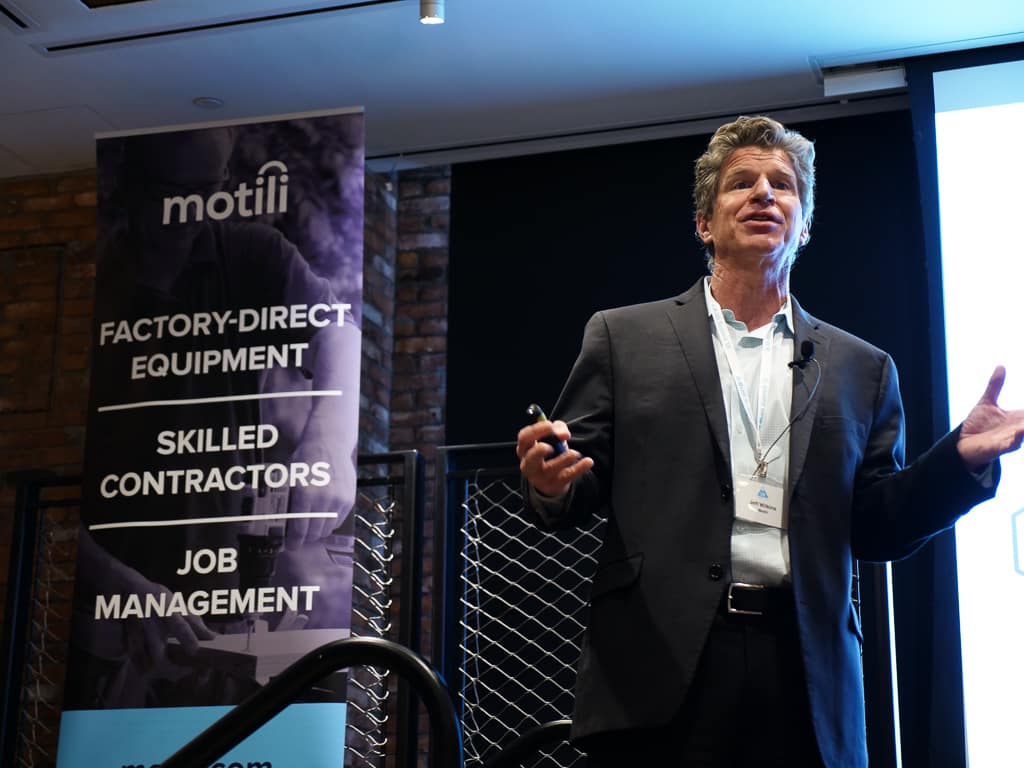

Alison: If a property owner wants to capitalize on the power of technology, what do you recommend as a first step?
Jeff: Motili has been transformative in empowering property owners, managers and investors do a better job in streamlining their facility’s management and maintenance decisions and their capital expenditure planning.
A technology like Motili’s offers three core benefits:
First is the ability to achieve significant savings by virtue of being able to aggregate your purchasing power across your portfolio of properties. Leveraging these technologies and the capabilities they provide can reduce a lot of internal cost associated with putting together and managing your own provider network for your properties.
Along with that is the simplicity of being able to have a single point of contact for all of these different types of repairs and maintenance.
A lot of our customers, particularly those with very complicated property portfolios and property footprints, have an enormous staff of folks out recruiting, managing, and motivating contractors. Sometimes that can be a bit of a “herding cats” exercise. Motili taking on that role, on behalf of our customers, provides a significant amount of simplicity.
The thing I’m most excited about, and I think where technology really resonates in adding value, is generating strategic insights for our clients. And by that I mean helping them spend their money more efficiently and more wisely.
A good first step is to gather data about what assets customers have on site, and then using that to form our customers’ predicted maintenance and planning schedule.
Alison: What makes Motili a unique technology in the marketplace, currently?
Jeff: Although this analogy is perhaps a bit tarnished today, because some of the issues they’ve had, we started out trying to create an “Uber” for HVAC – that was the founding vision for our company.
We’re essentially building a set of web platforms and mobile applications to create synergy between three sets of stakeholders:
The first is our client base which is both residential and commercial property owners, managers, and investors.
The second, our network of independent contractors that we work with to perform the labor aspect of the repair and the placement.
And then the third set of stakeholders are the manufacturers from whom we source, in a factory-direct way, equipment for those repairs and replacements.
We’ve streamlined the process, taken a lot of the cost, and the delays, and increased the timeliness of the offering by using technology intelligently to diagnose, repair, and replace those types of things as they arise.
Alison: Theresa Gallas, the President of SBOA, recently used Motili for a job in her home and said it was the easiest thing to do. The Motili quote she got was about $2,000 below every other quote she received. How are you able to produce consistent saving for customers?
Jeff: It’s really a function of our factory-direct model.
If you think about it, most of the people reading this are probably working with a local contractor who is buying equipment or supplies from a retailer who buys them from a wholesaler, who buys them from a manufacturer.
Each of those steps, in a multi-step distribution model, has markup.
And by virtue of having ERP-level integration, technical integration, and direct-from-factory buying capabilities, we’re able to pass on some of those savings to our clients and I think that’s what Theresa experienced.
Alison: How does technology afford a new owner or operator an advantage?
Jeff: We have a number of clients in self-storage that have taken properties and added climate control to them. These were facilities that didn’t have HVAC installed, or they were in such poor repair that they were not really useful.
The financial returns have been pretty staggering.
I have an example I can share, where one of our self-storage customers spent $31,800 on an HVAC build out. That allowed them to generate incremental rents in the first year of $56,772. So if you use a cap rate of 6%, what that means is, he increased the value of his building $946,200, on a $31,000 investment. Pretty good ROI on that one I think!
This is just one example of a customer wondering what they can achieve by implementing technology in a traditionally low-tech space.
As customers start to become fluent in technologies, and adopt them, and have a process in place to refine their approach through data-driven decision making, there are great opportunities to realize efficiencies, and cost savings in ongoing maintenance.
Alison: What are some kind of good things to be mindful of pertaining to repairs and maintenance when you first take ownership?
Jeff: The first thing is to know what assets are at your facility.
I haven’t personally spent 20 years in the building property space, but one of those “Aha!” moments for me – coming into this industry – was realizing how few customers have line of sight of what’s actually in their facilities – particularly important when you’re buying something new.
It’s probably an afterthought… “What type of HVAC system do I have?”, “If I’ve got plumbing fixtures or water heaters on site, what sort of state of repair are they in?” – important questions, too seldomly asked.
The first thing we recommend is to do an asset tracking project.
Someone like Motili, or another vendor, goes out and assesses your equipment and gathers metadata about that unit. That could be everything from brand, model number, date of manufacture, tonnage, or refrigerant type.
Then, as you look at any repair that comes in, ultimately we try to get our clients to think, “Should I be repairing this unit, or should I be replacing it? And what’s the ROI for either of those paths?”
The only way that you can make informed decisions is to have enough data to know how to plan for the future.
Alison: You have a large network of contractors, how do you make sure that you are protecting your reputation?
Jeff: It’s a great question. When we were first starting out, we didn’t have any experience with contractors. What do you do as an entrepreneur? You go out and you look at reviews on “independent” websites.
We looked at HomeAdvisor, we looked at Better Business Bureau, Build Zoom, Google – four or five different sites.
What was really fascinating to me, though is you would think surely Home Advisor and Google reviews should have similar ratings for a contractor… Turns out the ratings were all over the place, across the various contractor review websites.
The existing data wasn’t very useful to us, so over the last several years, the way we’ve done that is we battle-tested our contractors. We field tested them in our own environment.
We have a whole set of KPI’s around how well our contractors perform at each step of the process. They have to be able to work with our tools and with our process.
Early on, we would get some guys that were fantastic technicians, but sometimes we would get these weird scribbled quotes faxed in – if you can believe that. We initially didn’t even have a fax number to give contractors, so we had to go dig one up.
It’s on of these things, you’re looking at this and you think, “This is probably not a good fit for our model, because we need people that are going to be taking a mobile-first approach, using our app out in the field, giving us the data we need to service clients well.”
Largely our experience has been garnered directly by measuring, at a very granular level, performance of contractors in our network. And then also, through extensive interviewing and surveying of our clients after jobs have been completed.
Alison: What are some common or simple repairs that have a major impact on the value of facilities?
Jeff: Other than that example I gave where the customer added climate control, I would say probably the biggest thing is to get preventive maintenance in place.
We see a lot of systems where we go out to see a property and we can see the air filters that haven’t been changed since Dwight Eisenhower was president.
Someone’s customers are breathing this air.
Aside from the obvious poor customer experience, inefficient maintenance also leads to inefficiencies because the back pressure on those air filters.
If you do a twice a year preventative maintenance, you can extend the life of your equipment pretty significantly.
The other thing that I think is a very cost effective diagnostic to do is to do asset tracking. Find out what you have on-site and use that to determine whether it’s worth making further repairs or not. I think that’s information that you need to gather. It can help you do a better job and save you a lot of money in the long run, too.
Learn more about the Storage Business Owners’ Alliance on their website.












